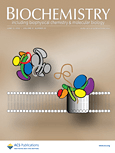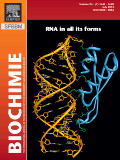
BIOCHEMISTRY
Scope & Guideline
Fostering collaboration in the world of biochemistry.
Introduction
Aims and Scopes
- Enzyme Mechanisms and Kinetics:
Research focusing on the detailed mechanisms of enzyme action, including kinetic studies and the influence of mutations or environmental factors on enzyme activity. - Structural Biology:
Investigations into the three-dimensional structures of proteins, nucleic acids, and complexes, utilizing techniques such as X-ray crystallography, NMR spectroscopy, and cryo-electron microscopy. - Molecular Interactions and Dynamics:
Studies that examine the interactions between biomolecules, including protein-protein, protein-nucleic acid, and protein-lipid interactions, often employing techniques like molecular dynamics simulations. - Biochemical Pathways and Metabolism:
Exploration of metabolic pathways, including biosynthesis and degradation processes, with a focus on enzymatic roles and regulatory mechanisms. - Chemical Biology and Drug Design:
Research that bridges chemistry and biology, focusing on the design and development of novel biomolecules and small molecules for therapeutic applications. - Biophysical Characterization:
Application of biophysical methods to characterize the properties and behaviors of biomolecules, including studies on folding, stability, and conformational changes.
Trending and Emerging
- Enzyme Engineering and Design:
A marked increase in research dedicated to the engineering and redesign of enzymes for improved functionality, specificity, and stability, often applying computational and synthetic biology techniques. - Biochemical Applications of Machine Learning:
Emerging interest in applying machine learning and AI-driven approaches to predict protein interactions, enzyme activities, and drug interactions, showcasing the intersection of data science and biochemistry. - Protein Phase Separation and Condensates:
Growing research into the phenomenon of biomolecular phase separation and the role of protein condensates in cellular processes, reflecting a shift towards understanding complex cellular organization. - G-Quadruplex Structures and Their Functions:
Increased focus on G-quadruplexes in nucleic acids, their roles in gene regulation, and their potential as therapeutic targets, indicating a rising interest in non-canonical nucleic acid structures. - Nanotechnology in Biochemistry:
The application of nanotechnology for drug delivery, biosensing, and the development of nanomaterials for biomedical applications has gained substantial traction, highlighting interdisciplinary research.
Declining or Waning
- Classical Enzyme Inhibition Studies:
Research centered on traditional enzyme inhibition mechanisms has decreased, possibly due to a shift towards more complex and nuanced studies involving allosteric regulation and multi-target interactions. - Basic Protein Expression Techniques:
Publications focusing solely on basic protein expression and purification methods have waned as more studies emphasize integrated approaches that combine structure-function analysis with functional assays. - Static Structural Analysis:
There is a notable decline in studies exclusively reporting static structural data without accompanying functional or dynamic insights, as the field increasingly values the understanding of molecular dynamics and interactions. - Single-Target Drug Discovery:
The focus on single-target drug discovery has diminished, with a growing preference for polypharmacology and the exploration of drug effects on multiple biological targets.
Similar Journals

BIOCHIMIE
Illuminating Pathways in Biochemistry and GeneticsWelcome to BIOCHIMIE, a prestigious journal dedicated to advancing the field of biochemistry and related areas of medicine. Published by Elsevier France - Editions Scientifiques Medicales Elsevier, this journal has been a cornerstone of scientific communication since its inception in 1971 and will continue to contribute essential research until 2024. With an impressive impact factor and categorized in Q2 for Biochemistry and Q1 for Miscellaneous Medicine, BIOCHIMIE ranks among the top quartiles in its fields, underscoring its significance and influence in the scientific community. Targeting a wide audience of researchers, professionals, and students, the journal publishes high-quality articles that explore innovative research and developments in biochemistry, genetics, and molecular biology, reflected in its Scopus ranking of 136 out of 438 in the biochemistry category. Despite its traditional publication format, the journal remains committed to promoting impactful research that drives the future of biochemistry and molecular medicine, ensuring that readers have access to critical insights that foster advancements in health and science.

Molecular Biomedicine
Bridging Disciplines for Impactful Biomedical ResearchMolecular Biomedicine is a prestigious peer-reviewed journal published by SpringerNature, dedicated to advancing the fields of molecular biology and molecular medicine. With a commendable Q1 ranking in both categories for 2023, this journal stands out for its rigorous exploration of the biochemical processes underlying health and disease. Operating out of Germany, Molecular Biomedicine aims to provide comprehensive insights into cutting-edge research, facilitating interdisciplinary collaboration among researchers, healthcare professionals, and students alike. The journal's impact is reflected in its Scopus rankings, placing it in the upper echelons of the fields of biochemistry, genetics, and molecular biology. As an open access platform, it commits to disseminating knowledge widely, ensuring that pivotal discoveries are accessible to all. Researchers looking to publish in a dynamic environment that prioritizes innovation and application in the biomedical sciences will find Molecular Biomedicine an ideal outlet for their work.

COMPARATIVE BIOCHEMISTRY AND PHYSIOLOGY B-BIOCHEMISTRY & MOLECULAR BIOLOGY
Unraveling Biochemical Mysteries Across SpeciesComparative Biochemistry and Physiology B: Biochemistry & Molecular Biology, published by Elsevier Science Inc, is a premier journal dedicated to the field of biochemistry and molecular biology with a specific focus on comparative analyses across various biological systems. Since its inception in 1971, the journal has made significant contributions to our understanding of the biochemical and physiological processes that differentiate organismal function across animal and aquatic life. The journal holds a commendable position in the academic community, evidenced by its 2023 rankings, which place it in the second quartile for Animal Science and Zoology and Aquatic Science, and the third quartile for both Biochemistry and Molecular Biology as well as Physiology. Researchers and students can access cutting-edge research through this highly respected publication, which continues to influence the future of biological sciences. While currently not an Open Access journal, its rigorous peer-review process ensures that only high-quality articles are disseminated, further solidifying its role as a critical resource for professionals and academics alike seeking to explore the intricate relationships between biochemical structures and physiological functions.

JOURNAL OF EVOLUTIONARY BIOCHEMISTRY AND PHYSIOLOGY
Exploring the Nexus of Biochemistry and Evolutionary DynamicsJOURNAL OF EVOLUTIONARY BIOCHEMISTRY AND PHYSIOLOGY, published by PLEIADES PUBLISHING INC, is a pivotal periodical that delves into the intricate relationships between biochemical processes and evolutionary dynamics. With its ISSN 0022-0930 and E-ISSN 1608-3202, this journal serves as a comprehensive platform for researchers, professionals, and students dedicated to understanding the physiological adaptations and biochemical mechanisms influenced by evolutionary pressures. Although it is not an open access journal, it offers valuable insights across its historically significant coverage spanning from 1972 to 2017, making it an essential resource for those working in agricultural, biological, and molecular sciences. Despite its current Scopus rankings revealing limited visibility within its fields, the journal remains committed to fostering scholarly dialogue and advancing knowledge in the realm of evolutionary biochemistry, especially for those exploring the ecological, genetic, and integrative physiological aspects of life.

INSECT MOLECULAR BIOLOGY
Innovating Insect Science with Molecular PerspectivesInsect Molecular Biology, published by Wiley, is a leading journal dedicated to advancing the field of insect biology through molecular perspectives. With a prominent ISSN of 0962-1075 and an E-ISSN of 1365-2583, this journal has gained a significant reputation since its inception in 1992, showcasing a diverse array of research that spans across genetics, molecular biology, and specific aspects of insect science. As of 2023, it has achieved a remarkable categorization, recognized as Q1 in Insect Science and Q3 in Genetics and Molecular Biology, underscoring its pivotal role in fostering academic discourse at the intersection of biology and technology. The journal is indexed in esteemed databases with strong rankings, sitting at the 82nd percentile in Insect Science, which highlights the impactful research it publishes. While it currently does not offer open access, Insect Molecular Biology remains an essential resource for researchers, students, and professionals eager to explore the complexities of insect life at the molecular level. By disseminating innovative findings and methodologies, the journal significantly contributes to both theoretical and applied entomological research, making it a cornerstone for anyone passionate about the intricate world of insects.

BIOCHEMISTRY-MOSCOW
Unveiling Innovations in Biochemical SciencesBIOCHEMISTRY-MOSCOW is a distinguished academic journal published by MAIK NAUKA/INTERPERIODICA/SPRINGER, focusing on pivotal research in the fields of biochemistry, biophysics, geriatrics, and broader medical sciences. Established in 1972, the journal has a rich history of disseminating critical findings and innovative studies, making significant contributions to the advancement of biochemical knowledge and applications. With its Q2 ranking in various categories including biochemistry and gerontology, the journal commands respect within the scientific community, offering a reputable platform for both established researchers and emerging scholars alike. Although traditionally not an open-access journal, it provides a wealth of information accessible through institutional subscriptions, ensuring the latest advancements reach a global audience. The journal aims to enhance understanding of biochemical processes and their implications for human health, and its commitment to high-quality peer-reviewed content has established it as a vital resource for those invested in the life sciences.

Biomolecules
Illuminating the path of discovery in molecular biology.Biomolecules is a prestigious, peer-reviewed journal published by MDPI that has been dedicated to advancing the field of biochemical research since its launch in 2011. With an impressive impact factor positioning it in Q1 for Biochemistry and Q2 for Molecular Biology as of 2023, this journal serves as a vital platform for disseminating high-quality research findings related to biological macromolecules, including proteins, nucleic acids, and carbohydrates. Operating as an Open Access journal, it ensures that vital research is accessible to all, furthering knowledge dissemination and collaboration within the scientific community. Located in Basel, Switzerland, the journal has established a significant presence in major academic databases, holding commendable Scopus rankings in both Biochemistry and Molecular Biology. Researchers, professionals, and students will find Biomolecules an invaluable resource for cutting-edge research, reviews, and insights in the rapidly evolving domains of biochemistry and molecular biology.

CELL BIOCHEMISTRY AND BIOPHYSICS
Illuminating the Interplay of Chemistry and Physics in CellsCELL BIOCHEMISTRY AND BIOPHYSICS is a distinguished journal published by HUMANA PRESS INC, focusing on critical advancements in the fields of biochemistry, biophysics, and cell biology. Since its establishment, the journal has provided a robust platform for the dissemination of cutting-edge research, covering diverse aspects of cellular biochemistry and the physical principles that underlie biological systems. With an emphasis on interdisciplinary studies, the journal aims to facilitate knowledge exchange among researchers, professionals, and students from various scientific backgrounds. As reflected in its 2023 category rankings, it holds a respectable position in Q3 for Biochemistry and Cell Biology, and Q2 for both Biophysics and Medicine (miscellaneous), indicating its significant contribution to these fields. Although it operates under a subscription model, the journal's commitment to maintaining high publication standards ensures that only impactful studies are shared with its audience. With a range of articles spanning theoretical insights to practical applications, CELL BIOCHEMISTRY AND BIOPHYSICS is an essential resource for those aiming to stay at the forefront of biochemical and biophysical research.

Journal of Biochemistry
Pioneering research in biochemistry and beyond.Journal of Biochemistry, published by Oxford University Press, is a prestigious academic journal that has been at the forefront of biochemical research since its inception in 1922. With an ISSN of 0021-924X and an E-ISSN of 1756-2651, this journal serves as a platform for disseminating high-quality research in the fields of biochemistry, molecular biology, and medicine, holding impressive rankings such as Q2 in Biochemistry and Medicine (miscellaneous) in 2023. As of 2024, the journal continues to explore significant topics in these areas, offering valuable insights for researchers, professionals, and students alike. The journal does not currently offer open access, but it remains a vital resource for anyone in the biochemical community seeking to stay updated on the latest discoveries and advancements. With its rich history and dedication to scientific excellence, the Journal of Biochemistry is an indispensable part of the scholarly landscape.

MOLECULAR AND CELLULAR BIOCHEMISTRY
Exploring Cellular Processes with PrecisionMOLECULAR AND CELLULAR BIOCHEMISTRY, an esteemed journal published by SPRINGER, serves as a prominent platform in the fields of biochemistry and molecular biology. With a history of dissemination since 1973, this journal has made significant contributions to the understanding of biochemical processes at the molecular level. The MOLECULAR AND CELLULAR BIOCHEMISTRY journal focuses on a myriad of topics including but not limited to cellular biochemistry, clinical biochemistry, and interdisciplinary approaches in medicine, boasting a commendable categorization in the 2023 Scopus ranks where it falls under Q3 in Cell Biology, Q2 in Clinical Biochemistry, Q1 in Medicine (miscellaneous), and Q2 in Molecular Biology. Although the journal is not open access, it provides access options through institutional subscriptions, making valuable research accessible to a wider audience. With its rigorous peer-review process and high impact within the scientific community, this journal aims to advance knowledge and stimulate exploration in biochemical research, making it essential reading for researchers, professionals, and students alike.